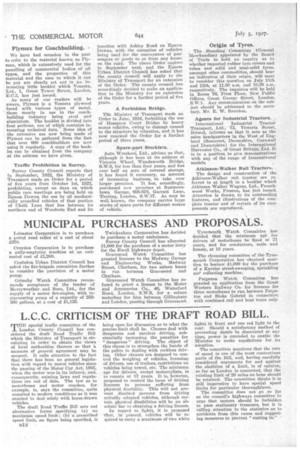L.C.C. CRITICISM OF THE DRAFT ROAD BILL.
Page 72

If you've noticed an error in this article please click here to report it so we can fix it.
T"special traffic committee of the London County • Council has considered the draft Road Traffic Bill which the Ministry of Transport is circulating in order to obtain the views of local authorities thereon so that it measure of general agreement may be secured. It calls attention to the fact that there has been no general legislation with regard to motor vehicles since the passing of the Motor Car Act, 1903, when the motor was in its infancy, and, consequently, existing laws and regulations are out of date. The law as to motorbuses and motor coaches, for example, is, says the committee, quite unsuited to modern conditions as it was enacted to deal solely with horse-drawn vehicles.
The draft Road Traffic Bill sets out alternative forms specifying (a) no maximum speed limit ; (b) a prescribed speed limit, no figure being specified, it D18 being open for discussion as to what the precise limit shall be. Clauses deal with dangerous and careless driving, substantially increasing the penalties for " dangerous " driving. The object of this clause is to strengthen the hands of the police in dealing with reckless driving. Other clauses are designed to control the weighing of vehicles, licensing of drivers, use of trailers, restrictions on vehicles being towed, etc. The minimum age for drivers, except motorcylists, is to remain at 17 years. It is, however, proposed to control the issue of driving licences to persons suffering from physical disability. This will not prevent disabled persons from driving suitably adapted vehicles, although certain physical disabilities will be an absolute bar to obtaining a driving licence.
In regard to lights, it is proposed that, in general, vehicles will be required to carry a maximum of two white lights in front and one red light to the rear. Should a satisfactory method of preventing dazzle be discovered at any time, power is conceded to enable the Minister to make regulations for its adoption.
The committee mentions that the rate of speed is one of the most contentious parts of the Bill, and, having carefully considered arguments for and against the abolition of a limit, is of opinion, so far as London is concerned, that the existing limit of 20 miles an hour should be retained. The committee thinks it is still imperative to have special speed limits for particular thoroughfares.
The committee does not go so far as the council's highways committee to urge that motors should be forbidden to pass stationary tramcars, but it is calling attention to the statistics as to accidents from this cause and Suggesting measures to prevent "cutting in."












































































































































































